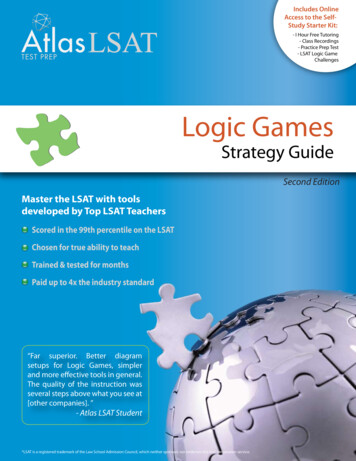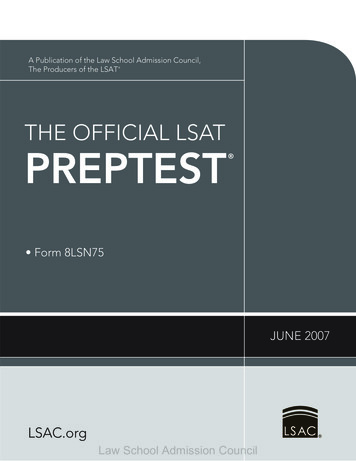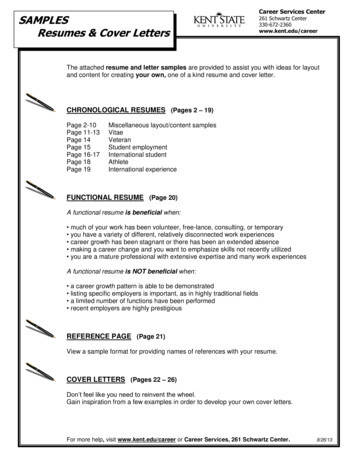
Transcription
Includes OnlineAccess to the SelfStudy Starter Kit:- I Hour Free Tutoring- Class Recordings- Practice Prep Test- LSAT Logic GameChallengesLogic GamesStrategy GuideSecond EditionMaster the LSAT with toolsdeveloped by Top LSAT TeachersScored in the 99th percentile on the LSATChosen for true ability to teachTrained & tested for monthsPaid up to 4x the industry standard“Far superior. Better diagramsetups for Logic Games, simplerand more effective tools in general.The quality of the instruction wasseveral steps above what you see at[other companies]. ”- Atlas LSAT Student*LSAT is a registered trademark of the Law School Admission Council, which neither sponsors nor endorses this test preparation service.
Atlas LSATLogic Games 2009 Atlas Prep, LLC
All actual LSAT questions printed within this work are usedwith the permission of Law School Admission Council, Inc.,Box 2000, Newtown, PA 18940, the copyright owner.LSAC does not review or endorse specific test preparationmaterials or services, and inclusion of licensed LSATquestions within this work does not imply the review orendorsement of LSAC.Each copyrighted LSAT question that appears in this book ismarked with the month and year of the exam from which itwas taken, and with the section and question number of theparticular question (e.g. December 2006, Section 2, #4).
Table of ContentsCHAPTER 1: Logic Games Overview.5CHAPTER 2: Relative Ordering & The Tree.13CHAPTER 3: Numbered Ordering & The Number Line.45CHAPTER 4: 3D Numbered Ordering & The 3D Number Line.79CHAPTER 5: Conditional Logic for Logic Games.113CHAPTER 6: Binary Grouping & The Logic Chain.135CHAPTER 7: Open Assignment & The Open Board.177CHAPTER 8: Closed Assignment & The Closed Board.207CHAPTER 9: Assess Your Progress.227
Logic GamesChapter 1Logic Games Overview5
Atlas LSATLogic Games on the LSATWhat Are Logic Games?The Analytical Reasoning section of the LSAT, more commonly called Logic Games, tests your ability to organize individualelements according to a given set of rules. Every logic game is comprised of three parts:1. The scenario. The scenario introduces the elements, usually people's names or letters representing objects, and providesthe context in which the elements are to be organized:On Monday, seven trains--F, G, H, J, K, M, and N--leave RivertownStation consecutively and one at a time. No other trains leave thestation on Monday.2. The constraints. The constraints, or rules, impose limitations on the relationships between and among the elements:Train J is the first or the seventh train to leave the station.Train H leaves the station before M, and exactly two trains leave thestation between H and M.Train N leaves the station either immediately before or immediatelyafter train M.Train K leaves the station third.3. The questions. The questions ask you to make inferences based on your understanding of the scenario and the constraints.Each game will have 5 to 7 associated questions. Here's an example:If train H leaves the station first, then which one of the following mustbe true?(A)(B)(C)(D)(E)Train F leaves the station second.Train F leaves the station sixth.Train M leaves the station fifth.Train N leaves the station fifth.Train G leaves the station second.The correct answer is (D). Later on, we'll discuss the approaches and methods that are best suited for this particular gametype. For now, know that you can count on every logic game having a scenario, a set of constraints, and 5-7 associatedquestions.The Modern Era of LSAT Logic GamesLogic Games were first introduced on the LSAT in 1982. While this section has not officially been changed since itsinception, there are noticeable differences between Logic Games sections administered before 2000 and those administeredsince. The post-2000, or modern era, Logic Games section differs in the following important ways:1. Fewer total questionsExams in the pre-2000 era commonly had 24 Logic Games questions per section. The modern era Logic Games sectiontypically has 22 or 23 questions.6
Logic Games2. Slightly less difficultOn average, modern era games tend to require less involved setups and less advanced inference skills. This is NOT to say thatmodern era games are easy! Simply keep this point in mind as you practice on a variety of games from before and after thedawn of the modern era.3. Less variationModern era games tend to follow more predictable patterns than those from earlier exams.This Logic Games Strategy Guide has been developed based on a careful review of exams administered on or after Octoberof 2000. This isn't to say we haven't used representative games from the old era, but the methods and insights presented inthis book are grounded in the most up-to-date trends and tendencies of the LSAT Logic Games section.Logic Games on Your ExamThe LSAT is comprised of the following sections (not necessarily in this order):SECTIONQUESTIONSSCORED?TIMELogic Games22-23yes35 minutesReading Comprehension26-28yes35 minutesLogical Reasoning (1)24-26yes35 minutesLogical Reasoning (2)24-26yes35 minutesEXPERIMENTAL22-28no35 minutesEssay1 essayno30 minutesThe Experimental section could be Logic Games, Reading Comprehension, or Logical Reasoning. Thus, you may receivetwo Logic Games sections on your exam. Even if you do, only one of those two sections will actually count towards yourfinal score (unfortunately, it's impossible to know which one as you are taking the exam).Every Logic Games section has exactly 4 games, each with 5-7 associated questions. In total, the Logic Games sectionaccounts for 22-23 questions of the 99-101 scored questions appearing on any LSAT exam.7
Atlas LSATGame TypesThree Organizational SchemesWe will spend a good amount of time later on in this book analyzing the specific details of the different game types that youwill be responsible for on your exam. For now, it's important to know that almost every logic game will ask you to organizeelements in one of the following three ways:1. Ordering:Your task is to order a set of individual elements.FGHJKMN12345672. Binary Grouping:Your task is to put elements into one of two distinct groups.FGHJKMNInvited to the partyNot invited3. Assignment:Your task is to assign elements to three or more categories.FGHJKMN8Dr. CummingsDr. DesmondDr. Edwards
Logic GamesBreakdown of Game TypesWithin the three organizational schemes outlined above there are a number of specific game types:GAME TYPE% of TOTALMETHODRelative14%TreeNumbered22%Number Line3D Numbered10%3D Number LineOpen10%Logic ChainClosed5%Logic ChainOpen14%Open BoardClosed19%Closed BoardMisc.7%ORDERINGBINARY GROUPINGASSIGNMENTOTHERThe percentages listed above give an indication of how prevalent each of the game types has been since the October 2000exam.Warning!Later on in this book, we will carefully examine each and every game type, and we will introduce the most efficient andeffective methods for tackling each game type. It is worth noting, however, that the data in the table above representtendencies, NOT absolutes. In other words, not every game will fall neatly into one of these boxes.One of the keys to Logic Games success is flexibility. If you become a strict "executor" of the recommended strategies andapproaches, you will have a harder time mastering the Logic Games section than, say, someone who is able to adapt his or herknowledge, skills, and methodologies to novel situations.9
Atlas LSATFrom Here to 170 The Logic Games DichotomyFlexibility is just one of the characteristics that separates the high-scorer from the average test-taker. Let's consider some ofthe others. When it comes to Logic Games, there is a big difference between the approaches, skills, and attitudes of theaverage scorer and the top scorer:MOST LSAT TEST-TAKERS170 TEST-TAKERSFail to recognize the different game typesQuickly recognize the game types;use this recognition to inform approachLack consistent and effective diagrammingmethodsDevelop and maintain consistentdiagramming methodsSpend too little or too much time on the setupUse instincts and experience to help them allocatetime wiselyUse trial-and-error as a primary approachUse key inferences to save time and workGet confused when a game or constraint straysfrom the normAre able to adapt their methods to workon the “curveball” game or constraintStruggle to apply the methods and approaches in areal test environmentPractice enough to achieve flexibility andproficiencyAre scared of logic gamesEnjoy doing logic games!Bridging the GapSo, how do you move from the left column to the right?Strengthen your game recognition skillsIt is important to be able to recognize the common characteristics associated with each game type. Quick game recognitionallows you to choose the most effective setup for the game at hand.Strengthen your setup skillsOnce you've recognized the game type, you must be able to diagram the game comfortably and quickly. Your setup/diagramwill serve as your main tool for making inferences and answering the questions.Strengthen your inference skillsMaking valid inferences is the key to Logic Games success. Through study and practice, you will begin to see the types ofinferences that are common to each of the game types.10
Logic GamesLearn to allocate time wiselySome games require more setup time than others. It's important to get a sense for when it's worth it to spend a bit of extratime on the setup and when it's not.Learn question-specific approachesIt is important to be able to recognize the common question types and to be proficient in the specific approaches best suitedfor each.The next chapter will cover our first game type, Relative Ordering. Let's get to it.11
Atlas LSAT12
Logic GamesChapter 2Relative Ordering & The Tree13
Atlas LSATGetting FamiliarTimed TrialDo your best to complete the following game in 8 minutes. Use whatever approach you see fit.Exactly eight rock bands--Moonshot, Nonesuch, Orbit,Plethora, Rewind, Simpleton, Truth, and Victim--performconsecutively at a showcase on Friday night. No bandperforms more than once, and no two bands performsimultaneously. The following conditions apply:Truth and Plethora both perform at some time beforeOrbit.Simpleton performs at some time before Rewind.Truth performs at some time before Nonesuch.Victim performs at some time after Simpleton.Moonshot performs at some time before Victim and atsome time after Orbit.1. Which of the following could be the order of theperformances from first to last?(A) Plethora, Truth, Orbit, Moonshot, Rewind,Simpleton, Victim, Nonesuch(B) Truth, Nonesuch, Moonshot, Plethora, Simpleton,Orbit, Victim, Rewind(C) Plethora, Truth, Nonesuch, Orbit, Moonshot,Victim, Simpleton, Rewind(D) Truth, Plethora, Nonesuch, Orbit, Simpleton,Moonshot, Victim, Rewind(E) Truth, Nonesuch, Orbit, Simpleton, Plethora,Rewind, Moonshot, Victim2. Which one of the following must be true?(A) At least four bands perform at some time afterPlethora.(B) At least four bands perform at some time afterTruth.(C) At least two bands perform at some time afterMoonshot.(D) At least two bands perform at some time beforeNonesuch.(E) At least two bands perform at some time beforeRewind.143. If Plethora performs fifth, then each of the followingcould be true EXCEPT:(A)(B)(C)(D)(E)Rewind is the sixth band to perform.Nonesuch is the fourth band to perform.Simpleton is the second band to perform.Truth is the third band to perform.Rewind performs at some time before Nonesuch butat some time after Truth.4. If Moonshot performs fourth, then which one of thefollowing must be true?(A)(B)(C)(D)(E)Victim is the sixth band to perform.Truth performs earlier than Plethora.Nonesuch performs earlier than Victim.Simpleton performs earlier than Nonesuch.Simpleton performs later than Orbit.5. Each of the following could be true EXCEPT:(A)(B)(C)(D)(E)Victim performs earlier than Nonesuch.Rewind performs earlier than Truth.Nonesuch performs earlier than Plethora.Simpleton performs later than Orbit.Moonshot performs earlier than Plethora.6. If the condition that Victim performs at some time afterSimpleton is replaced with the condition that Victimperforms at some time before Simpleton, and if all otherconditions remain in effect, then which of the followingmust be false?(A)(B)(C)(D)(E)Rewind performs last.Nonesuch performs last.Simpleton performs seventh.Victim performs fifth.Moonshot performs sixth.
Logic GamesRecognizing Relative Ordering GamesIn the modern era of Logic Games, 14% of all games are Relative Ordering games. Moreover, Relative Ordering games seemto be increasing in frequency on more recent exams. Two out of the four games on the September 2007 exam, for example,were Relative Ordering games. Let's first learn how to spot these games, and then we'll discuss the best method for attackingthem.Scenario CuesRemember that each logic game has three distinct parts: (1) the scenario, (2) the constraints, and (3) the questions. Thescenario always provides important information about which of the three main organizational schemes--Ordering, BinaryGrouping, or Assignment--you are dealing with. There are a number of words and phrases that commonly appear in thescenario section of Ordering games. Here is a list of the most common Ordering cues, and an example for each:1. "Order" or "Rank"A sales agent makes eight phone calls, one each to exactly eight potential clients--Q, R, S, T,V, W, X, and Y. The order of the phones calls depends on the following conditions.Six employees--Jones, Kilroy, Lee, Moore, Nielson, and Ortiz--are ranked from 1 to 6 basedon job performance.2. "Sequentially," "Consecutively," or "In succession"Six runners--Mason, Nguyen, Oh, Pearson, Smith, and Riley--race in the 100 meter dash.Each runner runs in exactly one of six lanes numbered sequentially 1 through 6.Seven trucks--F, G, H, J, K, L, and M--arrive at a pick-up station one at a time andconsecutively.A mail carrier visits eight homes--Q, R, S, T, V, W, X, and Y--one at a time and insuccession.3. "None simultaneously" or "No ties"A disc jockey plays seven songs--F, G, H, J, K, L, and M--consecutively on her eveningradio program. No two songs are played simultaneously.At the Buford Lake Regatta, six sailboats--Q, R, S, T, V, and W--cross the finish line insuccession. No other boats cross the finish line, and there are no ties.4. "Exactly once"A film critic sees five movies--Steer, Triangular, Undone, Victorious, and Wail--one at a timeand consecutively. She sees each movie exactly once.Keep in mind that the scenario section of an Ordering game may contain one or more of these cues. While these scenariocues help to define the broad Ordering organizational scheme, it's the language in the constraints that helps us to identify thespecific type of Ordering game at hand.15
Atlas LSATConstraint CuesRelative Ordering games are characterized by constraints that use relative language (as opposed to constraints that use"numbered" language; these types will be discussed in the next chapter) to define limitations on the given elements. Take alook at the following examples:1. "At some time before" or "At some time after"Miller arrives at some time before Keagan.Chang interviews at some time after Lorens.S is delivered at some time after T but at some time before W.2. "Earlier than" or "Later than"The television is installed earlier than the radio.Roberts speaks later than Murray.X is presented later than Y but earlier than Z.Putting it TogetherLet's apply these recognition skills to the "Rock Band" game appearing at the start of the chapter:Exactly eight rock bands--Moonshot, Nonesuch, Orbit,Plethora, Rewind, Simpleton, Truth, and Victim--performconsecutively at a showcase on Friday night. No bandperforms more than once, and no two bands performsimultaneously. The following conditions apply:Truth and Plethora both perform at some time beforeOrbit.Simpleton performs at some time before Rewind.Truth performs at some time before Nonesuch.Victim performs at some time after Simpleton.Moonshot performs at some time before Victim but atsome time after Orbit.Notice that in each of the examples above, and in the game above, the constraints give only relative information concerningthe position of one element with regard to another. We don't know, for example, how much later Victim performs relative toSimpleton. Does Victim perform immediately after Simpleton? Perhaps Victim and Simpleton are separated by two otherbands? Maybe three? It is this uncertainty that makes Relative Ordering games difficult to handle. Let's look at this challengein more detail, and then we'll propose a method for managing the uncertainty.16
Logic GamesSetup: The TreeThe Challenges of Relative OrderingDiagramming Relative Ordering games is difficult because of the uncertainty associated with the distance between elements.Again, while "A comes at some time before B" certainly gives us relative information, we don't know what comes between Aand B, if anything. Using our example from before, let's illustrate an ineffective way to diagram a Relative Ordering game.Exactly eight rock bands--Moonshot, Nonesuch, Orbit,Plethora, Rewind, Simpleton, Truth, and Victim--performconsecutively at a showcase on Friday night. No bandperforms more than once, and no two bands performsimultaneously. The following conditions apply:GIVEN CONSTRAINTTruth and Plethora both perform at some timebefore Orbit.UPDATED DIAGRAMTPTSimpleton performs at some time beforeRewind.Truth performs at some time before Nonesuch.Victim performs at some time after Simpleton.Moonshot performs at some time beforeVictim but at some time after Orbit.POORTNOSRTNOPDoes S go before T?Does S go before P?What about R?!Does N go before or after O?Does N go before or after P?Does V go before or after R?SRVTNO M?PWhich comes first, T or P?Does S go before O?SPUNCERTAINTYS RM? VWhat a mess!! I've losttrack of what's certain andwhat's uncertain!17
Atlas LSATThe TreeWe need a method through which we can quickly symbolize the constraints while effectively managing the uncertainty. Let'stry this again using The Tree approach:STEP 1: Start with the first constraint, drawing a line betweenany two letters for which the relative positioning is known.Truth and Plethora both perform at some time before Orbit.Simpleton performs at some time before Rewind.Truth performs at some time before Nonesuch.Victim performs at some time after Simpleton.Moonshot performs at some time before Victim but at some timeafter Orbit.NOTE: We have arbitrarilydecided that earlier elementswill be placed to the LEFT oflater elements. You couldeasily decide to do it the otherway around. It doesn't matter,as long as you are consistent.TOPSTEP 2: Then find the next constraint that can be connected toany part of the existing diagram.NTruth and Plethora both perform at some time before Orbit.Simpleton performs at some time before Rewind.Truth performs at some time before Nonesuch.Victim performs at some time after Simpleton.Moonshot performs at some time before Victim but at some timeafter Orbit.NOTE: Since we're skippingaround, we want to keep trackof our progress through theconstraints by crossing off theones we've already used.TOPSTEP 3: Repeat until all constraints have been used.Remember to draw lines only between those letters for whichthe relative position is known.Truth and Plethora both perform at some time before Orbit.Simpleton performs at some time before Rewind.Truth performs at some time before Nonesuch.Victim performs at some time after Simpleton.Moonshot performs at some time before Victim but at sometime after Orbit.Truth and Plethora both perform at some time before Orbit.Simpleton performs at some time before Rewind.TTruth performs at some time before Nonesuch.Victim performs at some time after Simpleton.Moonshot performs at some time before Victim but atPsome time after Orbit.Truth and Plethora both perform at some time before Orbit.Simpleton performs at some time before Rewind.Truth performs at some time before Nonesuch.Victim performs at some time after Simpleton.Moonshot performs at some time before Victim but atsome time after Orbit.18NTOMVPNOMNOTE: It doesn't matterif we draw S pointing upor down from V, as longas it is clearly LEFT of V.VSNTOPMVSR
Logic GamesDifferent Versions of the Same RelationshipsAs you draw your own Tree diagrams and compare them with those in this book, you may sometimes note slight orientationdifferences between your version and the solution. This is okay as long as the horizontal solid line connections between theletters are the same in both diagrams. Here's an example to illustrate:Diagram 1:Diagram 2:SNNOTOPMVSRTRVMPNote that Diagram 1 and Diagram 2 look very different at first glance. Don't be fooled; they actually represent the samerelationships. In both diagrams, T has exactly two connections: N is after T and O is after T. Similarly, V has exactly twoconnections in both diagrams: M is before V and S is before V. Upon close examination, you will see that all the connectionsare exactly the same from one diagram to the other. In short, it is the horizontal (from left to right) connections between andamong letters that are important, not the vertical (up and down) orientation of the letters. So, when you check the validity ofyour Tree diagrams, be sure to check these horizontal connections and NOT the overall shape of the picture.The completed Tree diagram consolidates the information from all the constraints and gives us a clear picture of therelationships between and among the elements. We will unlock the power of The Tree momentarily when we discuss how todraw inferences from the diagram in order to answer questions. First, let's get more comfortable with the setup process bydrilling the mechanics.19
Atlas LSATDRILL IT: Tree Setup MechanicsInstructionsEach mini-drill will contain one or more constraints. Your task is to construct a Tree diagram for each mini-drill. Be sure tocheck your diagram against the solution on the next page AFTER EACH AND EVERY PROBLEM. Make sure youunderstand it before moving on to the next exercise.Example: O departs at some time before P.OP8. Both M and H are written later than N.J is written earlier than K.K is written earlier than N.O is written at some time before H but after J.1. J leaves at some time before K but after L.2. Both R and S arrive earlier than Q.9. Both T and V call at some time before M.N calls at some time after R.O calls at some time before N but after M.P calls at some time before M.T calls at some time before S.3. K presents earlier than both M and N.K presents later than G.4. X is built later than Y but earlier than Z.W is built later than Y.5. B interviews at some time before F.Both D and G interview at some time before B.H interviews at some time after D.6. H and J both speak at some time before N.K speaks at some time after P.P speaks at some time before H.7. X plays earlier than W but later than T.Y plays later than Z.Z plays earlier than X.2010. M arrives at some time after O.L arrives earlier than NJ arrives a at some time after L but before P.S arrives at some time after J.N arrives later than O.11. Both S and Y finish at some time before R.T finishes at some time after X.S finishes at some time after W but before V.X finishes later than S.Y finishes later than W.12. K is produced at some time after N but before O.Both L and J are produced at some time before N.M is produced at some time after P.R is produced at some time before O.J is produced at some time before M.
Logic GamesSOLUTIONS: Tree Setup MechanicsExample: O departs at some time before P.O8. Both M and H are written later than N.J is written earlier than K.K is written earlier than N.O is written at some time before H but after J.P1. J leaves at some time before K but after L.LJKRSQTPVMNK4. X is built later than Y but earlier than Z.W is built later than Y.XWZHBF6. H and J both speak at some time before N.K speaks at some time after P.P speaks at some time before H.KHJPN7. X plays earlier than W but later than T.Y plays later than Z.Z plays earlier than X.TZXYM10. M arrives at some time after O.L arrives earlier than NJ arrives at some time after L but before P.S arrives at some time after J.ON arrives later than O.WORMNJL5. B interviews at some time before F.Both D and G interview at some time before B.H interviews at some time after D.DGH9. Both T and V call at some time before M.N calls at some time after R.O calls at some time before N but after M.P calls at some time before M.ST calls at some time before S.3. K presents earlier than both M and N.K presents later than G.YKO2. Both R and S arrive earlier than Q.GJMNNPS11. Both S and Y finish at some time before R.T finishes at some time after X.S finishes at some time after W but before V.X finishes later than S.Y finishes later than W.WSXVRTY12. K is produced at some time after N but before O.Both L and J are produced at some time before N.M is produced at some time after P.R is produced at some time before O.J is produced at some time before M.RLJPNKOM21
Atlas LSATTime AllocationSetup Time vs. Question TimeIn Chapter 1, we briefly discussed the importance of wise time allocation. On some games, you will do yourself a favor byspending more time on the setup, while on others you will be better served by moving to the questions sooner:Front-loaded pacing plan (most extreme case):SETUP6 minQUESTIONS3 minBack-loaded pacing plan (most extreme case):SETUP1 minQUESTIONS8 minAs you were drilling your Tree mechanics, you may have noticed that the Tree setup is not very time intensive (assuming youcan execute the mechanics without too much trouble). Generally speaking, the Tree setup should take about 1 minute tocomplete, leaving you with plenty of time to tackle the questions. The good news is that once you have your completed Treedown on paper, you've basically "solved" the game. Answering the questions becomes an exercise in reading the Tree (aswe'll see momentarily).Strategically speaking, you should aim to complete your Tree setup in about 1 minute. You should be finished with the entiregame (reading the scenario and constraints, setting up the Tree, and answering all the questions) in about 5-7 minutes,depending on the number of questions. Relative Ordering games represent an opportunity to put time in the bank, or to makeup time if you've fallen behind.These are obviously guidelines and not absolutes. Your own pacing will depend on your comfort level and your skill level.We've discussed and drilled the setup skills; now we'll learn how to read The Tree to make inferences and answer questions.22
Logic GamesInferences: Reading The TreeTwo RulesBy properly setting up your Tree diagram, you are in essence uncovering and relating all of the key inferences required toanswer the questions. Your ability to utilize these inferences, however, depends on your ability to correctly read The Tree.There are two important rules that you must keep in mind. We'll discuss these rules one at a time using our completed Treediagram from our rock band example.NTOPMVSRRULE #1: The relative position between two elements, or letters, can be determined if you can trace a continuous pathbetween these two elements without changing the horizontal direction of your path.Example: P to VStarting at P, we can follow a solid line to the right towards O, continue to the right towards M, and again trace to the right toarrive at V. Note that we have traced a continuous path from P to V, and we did not have to change horizontal directions to doso (we moved to the right the entire time). Thus, the position of P relative to V is known. Even though the constraints neverreferenced a direct relationship between the two, we can infer that P sits somewhere before V (with at least O and M betweenthem).Example: M to TFrom M, we can follow a solid line to the left towards O, then continue on a solid line to the left arriving at T. Thus, we canconclude that T sits somewhere before M.RULE #2: The relative position between two elements, or letters, cannot be determined if the path between the two lettersincludes one or more changes in horizontal direction.Example: N to OFrom N, we can follow a solid line to the left towards T, but then we must change horizontal directions, moving back to theright to arrive at O. Thus, the position of N relative to O cannot be determined. N could come somewhere before O, but itcould also come somewhere after O.Example: P to RThis is a tough one. It looks like P comes before R, but the relationship between them is actually unknown. Remember, theTree is a map of relative position, NOT a physical picture of order. From P, we can follow continuous, solid lines to the righttowards V, but then we must change horizontal directions back to the left towards S, and then change again to move righttowards R. Thus, the position of P relative to R cannot be determined. P could come somewhere before R, but it could alsocome somewhere after R. Keep in mind that
The LSAT is comprised of the following sections (not necessarily in this order): The Experimental section could be Logic Games, Reading Comprehension, or Logical Reasoning. Thus, you may receive two Logic Games sections on your exam. Even if you do, only o











